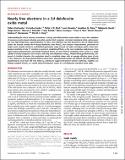Files in this item
Nearly-free electrons in a 5d delafossite oxide metal
Item metadata
| dc.contributor.author | Kushwaha, Pallavi | |
| dc.contributor.author | Sunko, Veronika | |
| dc.contributor.author | Moll, P.J.W. | |
| dc.contributor.author | Bawden, Lewis | |
| dc.contributor.author | Riley, Jonathon Mark | |
| dc.contributor.author | Nandi, Nabhanila | |
| dc.contributor.author | Rosner, H. | |
| dc.contributor.author | Schmidt, M.P. | |
| dc.contributor.author | Arnold, F. | |
| dc.contributor.author | Hassinger, E. | |
| dc.contributor.author | Kim, T.K. | |
| dc.contributor.author | Hoesch, M. | |
| dc.contributor.author | Mackenzie, Andrew | |
| dc.contributor.author | King, Phil | |
| dc.date.accessioned | 2015-10-26T09:40:00Z | |
| dc.date.available | 2015-10-26T09:40:00Z | |
| dc.date.issued | 2015-10-23 | |
| dc.identifier | 211104533 | |
| dc.identifier | 5064dc6c-24f8-45d6-b2d6-2c796adbd139 | |
| dc.identifier | 85008221704 | |
| dc.identifier | 000216598200034 | |
| dc.identifier.citation | Kushwaha , P , Sunko , V , Moll , P J W , Bawden , L , Riley , J M , Nandi , N , Rosner , H , Schmidt , M P , Arnold , F , Hassinger , E , Kim , T K , Hoesch , M , Mackenzie , A & King , P 2015 , ' Nearly-free electrons in a 5 d delafossite oxide metal ' , Science Advances , vol. 1 , no. 9 , e1500692 . https://doi.org/10.1126/sciadv.1500692 | en |
| dc.identifier.issn | 2375-2548 | |
| dc.identifier.uri | https://hdl.handle.net/10023/7689 | |
| dc.description.abstract | Understanding the role of electron correlations in strong spin-orbit transition-metal oxides is key to the realization of numerous exotic phases including spin-orbit–assisted Mott insulators, correlated topological solids, and prospective new high-temperature superconductors. To date, most attention has been focused on the 5d iridium-based oxides. We instead consider the Pt-based delafossite oxide PtCoO2. Our transport measurements, performed on single-crystal samples etched to well-defined geometries using focused ion beam techniques, yield a room temperature resistivity of only 2.1 microhm·cm (μΩ-cm), establishing PtCoO2 as the most conductive oxide known. From angle-resolved photoemission and density functional theory, we show that the underlying Fermi surface is a single cylinder of nearly hexagonal cross-section, with very weak dispersion along kz. Despite being predominantly composed of d-orbital character, the conduction band is remarkably steep, with an average effective mass of only 1.14me. Moreover, the sharp spectral features observed in photoemission remain well defined with little additional broadening for more than 500 meV below EF, pointing to suppressed electron-electron scattering. Together, our findings establish PtCoO2 as a model nearly-free–electron system in a 5d delafossite transition-metal oxide. | |
| dc.format.extent | 2013297 | |
| dc.language.iso | eng | |
| dc.relation.ispartof | Science Advances | en |
| dc.subject | PtCoO2 | en |
| dc.subject | Delafossite oxide | en |
| dc.subject | 5d metal | en |
| dc.subject | Nearly-free electrons | en |
| dc.subject | QC Physics | en |
| dc.subject | DAS | en |
| dc.subject.lcc | QC | en |
| dc.title | Nearly-free electrons in a 5d delafossite oxide metal | en |
| dc.type | Journal article | en |
| dc.contributor.sponsor | The Royal Society | en |
| dc.contributor.sponsor | EPSRC | en |
| dc.contributor.institution | University of St Andrews. School of Physics and Astronomy | en |
| dc.contributor.institution | University of St Andrews. Condensed Matter Physics | en |
| dc.identifier.doi | https://doi.org/10.1126/sciadv.1500692 | |
| dc.description.status | Peer reviewed | en |
| dc.identifier.grantnumber | UF120096 | en |
| dc.identifier.grantnumber | EP/I031014/1 | en |
This item appears in the following Collection(s)
Items in the St Andrews Research Repository are protected by copyright, with all rights reserved, unless otherwise indicated.

